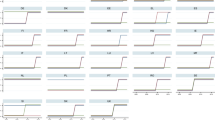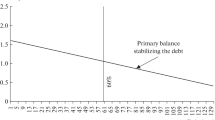Abstract
Well-designed and effectively implemented fiscal rules hold a lot of promise. They may help contain a deficit bias, reduce the time inconsistency of budgetary policies, strengthen the credibility of a government’s commitment to fiscal sustainability and facilitate countercyclical fiscal management. By increasing the predictability of fiscal policy, fiscal rules can also lower output volatility and boost long-term growth.
Access this chapter
Tax calculation will be finalised at checkout
Purchases are for personal use only
Preview
Unable to display preview. Download preview PDF.
Similar content being viewed by others
References
Alesina, A., R. Hausmann, R. Hommes and E. Stein. 1996. “Budget Institutions and Fiscal Performance in Latin America,” IADB Working Paper no.394.
Alesina, A., and R. Perotti. 1995. “The Political Economy of Budget Deficits,” IMF Staff Papers 1–31. Washington, DC: International Monetary Fund.
Alt, J. E., and R. C. Lowry. 1994. “Divided Government, Fiscal Institutions, and Budget Deficits: Evidence from the States,” American Political Science Review 88(4).
Anderson, B., and J. J. Minarik. 2006. “Design Choices for Fiscal Policy Rules,” Paper for OECD Working Party for Senior Budget Officials GOV/PGC/SBO 4.
Ayuso-i-Casals, J., D. G. Hernandez, L. Moulin and A. Turrini. 2006. “Beyond the SGP – Features and Effects of EU National-Level Fiscal Rules,” prepared for the workshop organized by the European Commission on “The Role of National Fiscal Rules and Institutions in Shaping Budgetary Outcomes,” Brussels, November 24, 2006.
Balassone, F., D. Franco and S. Zotteri. 2004. “EMU Fiscal Rules and Fiscal Decentralization,” Presupuesto y Gasto 35(2): 63–97.
Balassone, F., and M. S. Kumar. 2007a. “Cyclicality of Fiscal Policy,” in T. Ter-Minassian, and M. S. Kumar (eds) Promoting Fiscal Discipline, pp. 19–35. Washington, DC: International Monetary Fund.
Balassone, F., and M. S. Kumar. 2007b. “Addressing the Procyclical Bias,” in T. Ter- Minassian, and M. S. Kumar (eds) Promoting Fiscal Discipline, pp. 36–57. Washington, DC: International Monetary Fund.
Caceres, C., A. Corbacho and L. Medina. 2010. “Structural Breaks in Fiscal Performance: Did Fiscal Responsibility Laws Have Anything to Do with Them?,” IMF Working Paper 10/248. Washington, DC: International Monetary Fund.
Corbacho, A., and G. Schwartz. 2007. “Fiscal Responsibility Laws,” in T. Ter-Minassian and M. S. Kumar (eds) Promoting Fiscal Discipline, pp. 58–77. Washington, DC: International Monetary Fund.
Corbacho, A. (coordinator). 2012. Las instituciones fiscales del mañana. Washington, DC: Inter-American Development Bank.
Danninger, S. 2002. “A New Rule: The Swiss Debt Brake,” IMF Working Paper WP/02/18. Washington, DC: International Monetary Fund.
Debrun, X., D. Hauner and M. S. Kumar. 2009. “Independent Fiscal Agencies,” Journal of Economic Surveys 23(1): 44–81.
Debrun, X., and M. S. Kumar. 2007a. “Fiscal Rules, Fiscal Councils and All That: Commitment Devices, Signaling Tools or Smokescreens?,” in Banca d’Italia (ed.), Fiscal Policy: Current Issues and Challenges, papers presented at the Banca d’Italia workshop held in Perugia, March 29–31, 2007, pp. 479–512.
Deroose, S., L. Moulin and P. Wierts. 2006. “National Expenditure Rules and Expenditure Outcomes: Empirical Evidence for EU Member States,” Wirtschaftspolitische Blaetter 1: 27–42.
European Commission. 2006. Public Finance Report in EMU – 2006. Part III: National Numerical Fiscal Rules and Institutions for Sound Public Finances, European Economy No. 3/2006. Brussels: European Commission.
European Commission. 2007. Public Finance Report in EMU – 2007, Part IV: Lesson from Successful Fiscal Consolidations, European Economy No. 3/2007. Brussels: European Commission.
European Commission. 2010. Public Finance Report in EMU – 2010, European Economy No. 4/2010. Brussels: European Commission.
Fatas, A., and I. Mihov. 2002. “The Case for Restricting Fiscal Policy Discretion,” Center For Economic Policy Research (CEPR), Discussion Paper No. 3277.
Fatas, A., and I. Mihov. 2006. “The Macroeconomic Effects of Fiscal Rules in the U.S. States,” Journal of Public Economics No. 90.
Fedelino, A., A. Ivanova and M. Horton. 2009. “Computing Cyclically Adjusted Balances and Automatic Stabilizers,” IMF technical note, published on IMF.org website.
Girouard, N., and C. André. 2005. “Measuring Cyclically-Adjusted Budget Balances for OECD Countries,” OECD Economics Department Working Paper No. 434.
IMF. 2009. “Fiscal Rules – Anchoring Expectations for Sustainable Public Finances,” published on IMF.org website.
Irwin, T. 2012. “Accounting Devices and Fiscal Illusions,” IMF Staff Discussion Note, SDN/12/02. Washington, DC: International Monetary Fund.
Joumard, I., and P. M. Kongsrud, “Fiscal Relations across Government Levels,” OECD Economics Department Working Paper No. 375.
Kopits, G. 2001. “Fiscal Rules: Useful Policy Framework or Unnecessary Ornament?,” IMF Working Paper WP/01/145. Washington, DC: International Monetary Fund.
Kopits, G. 2004. “Overview of Fiscal Policy Rules in Emerging Markets,” in Kopits, G. (ed.), Rules-Based Fiscal Policy in Emerging Markets. Background, Analysis, and Prospects, pp. 1–11. London: Palgrave Macmillan.
Kopits, G. 2011. “Independent Fiscal Institutions: Developing Good Practices,” OECD Journal on Budgeting, November.
Kopits, G., and S. Symansky. 1998. “Fiscal Rules,” IMF Occasional Paper 162.
Kuttner, K. N. 1994. “Estimating Potential Output as a Latent Variable,” Journal of Business and Economic Statistics 12(3).
Kyobe A., and S. Danninger, “Revenue Forecasting: How Is It Done? Results from a Survey of Low-Income Countries,” IMF Working Paper, WP/05/24. Washington, DC: International Monetary Fund.
Larch, M., and A. Turrini. 2009. “The Cyclically-Adjusted Budget Balance in EU Fiscal Policy Making: A Love at First Sight Turned into a Mature Relationship,” European Economy – Economic Papers No. 374.
Ljungman, G. 2008. “Expenditure Ceilings – A Survey,” IMF Working Paper WP/08/282. Washington, DC: International Monetary Fund.
Marcel, M. 2009. “La Regla de Balance Estructural en Chile: Diez Años, Diez Lecciones,” mimeo.
OECD. 2004. “Asset Price Cycles, ‘One-Off Factors’ and Structural Budget Balances,” Ch. VI of Economic Outlook, No.75, OECD, Paris.
Price, R., and T. Dang. 2011. “Adjusting Fiscal Balances for Asset Price Cycles,” OECD Economics Department Working Paper No. 868.
Schaechter, A., T. Kinda, N. Budina and A. Webber. 2012. “Fiscal Rules in Response to the Crisis – Toward the ‘Next Generation’ Rules,” IMF Working Paper WP/12/187. Washington, DC: International Monetary Fund.
Sutherland, D., R. Price and I. Joumard. 2005. “Fiscal Rules for Sub-central Levels of Government: Design and Impact,” OECD Economics Department Working Paper No. 465. Paris: Organisation for Economic Co-operation and Development.
Ter-Minassian, T. 2010. “Preconditions for a Successful Introduction of Structural Fiscal Rules in Latin America and the Caribbean: A Framework Paper,” IDB Discussion Paper No. 157.
Ter-Minassian, T., and J. Craig. 1997. “Control of Sub-national Borrowing,” in T. Ter-Minassian (ed.), Fiscal Federalism in Theory and Practice. Washington, DC: International Monetary Fund.
Ter-Minassian, T., and A. Fedelino. 2010. “Impact of the Global Crisis on Sub-national Governments’ Finances,” IEB, Fiscal Federalism Report, Barcelona, Spain.
Von Hagen, J. 2005. “Fiscal Rules and Fiscal Performance in the EU and Japan,” CEPR Discussion Paper No. 5330.
Von Hagen, J., and I. Harden. 1995. “Budget Processes and Commitment to Fiscal Discipline,” European Economic Review 39(3–4).
Wyplosz, C. 2005. “Fiscal Policy: Institutions vs. Rules,” National Institute Economic Review No.191.
Editor information
Copyright information
© 2013 Ana Corbacho and Teresa Ter-Minassian
About this chapter
Cite this chapter
Corbacho, A., Ter-Minassian, T. (2013). Public Financial Management Requirements for Effective Implementation of Fiscal Rules. In: Allen, R., Hemming, R., Potter, B.H. (eds) The International Handbook of Public Financial Management. Palgrave Macmillan, London. https://doi.org/10.1057/9781137315304_3
Download citation
DOI: https://doi.org/10.1057/9781137315304_3
Publisher Name: Palgrave Macmillan, London
Print ISBN: 978-1-349-33598-5
Online ISBN: 978-1-137-31530-4
eBook Packages: Palgrave Economics & Finance CollectionEconomics and Finance (R0)




